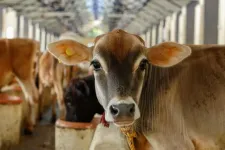(Press-News.org) All plants mediate their environmental interactions via chemical signals. An example is the alkaloid gramine produced by barley, one of the world’s most widely grown cereals. Gramine provides protection against herbivorous insects and grazing animals and inhibits the growth of other plants. Despite long-standing interest, the key gene for the formation of gramine remained elusive.
The researchers discovered a cluster of two genes in barley for gramine biosynthesis. The first gene (HvNMT) had already been discovered 18 years ago. In their study the researchers from IPK and the Leibniz University Hannover now identified a second gene (AMI synthase, HvAMIS), and found out that both genes are located in proximity of each other on the same chromosome. With this discovery, the pathway of gramine biosynthesis is now fully elucidated.
“We discovered that AMIS is an oxidase enzyme that carries out an unusual cryptic oxidative rearrangement of tryptophan, allowing us to revise the previous biosynthetic proposal from the 1960s”, says Dr. John D’Auria, head of IPK’s research group “Metabolic Diversity”. Prof. Dr. Jakob Franke, head of the group “Biochemistry of Plant Specialised Metabolites” at Leibniz University Hannover, adds: “We were very surprised by the so far unknown enzyme mechanism by which gramine is formed. At the same time, we now have the possibility to produce biologically active alkaloids with sustainable biotechnological methods.”
The research team could produce gramine in yeast and model plants (Nicotiana benthamiana, Arabidopsis). “In contrast to many other protective metabolites from plants, production of gramine requires only two genes. Therefore, using our findings for practical applications is relatively straightforward”, emphasises Ling Chuang from Leibniz University Hannover, one of the first authors. “Furthermore, genetic engineering of barley allowed us to produce gramine in a non-gramine producing barley variety, and eliminate gramine production in a gramine producing barley variety by genome editing”, explains the other first author Sara Leite Dias, International Max Planck Research School funded researcher at the IPK.
“The results set the basis to produce gramine in organisms without the native ability to synthesize it for purposes such as a natural plant protection agent, or to eliminate gramine from barley and other grasses to reduce toxicity towards ruminants”, says Dr. John D’Auria. “Our findings set the ground for improving barley to increase its resistance to pests, reduce its toxicity to ruminants and contribute to sustainable weed management.”
Original publication:
Leite Dias et al. (2024): Biosynthesis of the allelopathic alkaloid gramine in barley by a cryptic oxidative rearrangement. Science. DOI: 10.1126/science.adk6112
Scientific Contact:
Dr. John D’Auria: Phone: +49 39482 5176; dauria@ipk-gatersleben.de
Prof. Dr. Jakob Franke: Phone: +49 511 762 2628 jakob.franke@botanik.uni-hannover.de
END
Researchers discover key gene for toxic alkaloid in barley
Joint press release of the IPK Leibniz Institute and the Leibniz University Hannover
2024-03-28
ELSE PRESS RELEASES FROM THIS DATE:
New approach to monitoring freshwater quality can identify sources of pollution, and predict their effects
2024-03-28
The source of pollutants in rivers and freshwater lakes can now be identified using a comprehensive new water quality analysis, according to scientists at the University of Cambridge and Trent University, Canada.
Microparticles from car tyres, pesticides from farmers’ fields, and toxins from harmful algal blooms are just some of the organic chemicals that can be detected using the new approach, which also indicates the impact these chemicals are likely to have in a particular river or lake.
Importantly, the approach can also point to the origin of specific organic matter dissolved in the water, because it has a distinct ...
Bidirectional link between premenstrual disorders and perinatal depression
2024-03-28
Women with premenstrual syndrome (PMS) or premenstrual dysphoric disorder (PMDD) have a higher risk of perinatal depression. Conversely, women with perinatal depression have a higher risk of developing premenstrual disorders. This is shown in a study from Karolinska Institutet published in the journal PLOS Medicine.
Premenstrual disorders like PMS or PMDD and perinatal depression are similar in the way that symptoms appear in connection with hormonal changes. This fact has given rise to the hypothesis ...
Cell division quality control ‘stopwatch’ uncovered
2024-03-28
Each day, hundreds of billions of cells in our body cycle through a period of growth and division. Yet in that time, only about 30 minutes is spent on the critical orchestration of mitosis, when chromosomes are carefully segregated from one parent cell to the next generation of two daughter cells.
It’s during this crucial period of cell division that things can go haywire. Chromosomes can be misdirected, leading to damaged and diseased cells that progress to different types of cancer. University of California San Diego scientists reporting in the journal Science have found a key mechanism that keeps track of mitosis timing and ...
Vaccine protects cattle from bovine tuberculosis, may eliminate disease
2024-03-28
UNIVERSITY PARK, Pa. — Bovine tuberculosis (TB) is a livestock disease that results in large economic losses to animal agriculture worldwide. The disease can also transmit to humans and cause severe illness and death. Researchers from Penn State, Addis Ababa University and the University of Cambridge have now demonstrated that a vaccine for TB currently used in humans significantly reduces infectiousness of vaccinated livestock, improving prospects for elimination and control. The study published today (March 28) in the journal Science.
The spillover ...
Andrew Siemion to receive the SETI Institute’s 2024 Drake Award
2024-03-28
March 28, 2024, Mountain View, CA -- The SETI Institute is pleased to announce that Dr. Andrew Siemion will be honored with the prestigious 2024 Drake Award for his exceptional and pioneering contributions to SETI and radio astronomy and his leadership in the field. Siemion's distinguished career includes his role as the Bernard M. Oliver Chair for SETI at the SETI Institute, Principal Investigator for the Breakthrough Listen Initiative at the University of Oxford, along with holding an Honorary Professorship ...
New study shows how the Crimean-Congo hemorrhagic fever virus enters our cells
2024-03-28
Researchers at Karolinska Institutet, in collaboration with JLP Health and others, have identified how the tick-borne Crimean-Congo haemorrhagic fever virus enters our cells. The results are published in Nature Microbiology and are an important step in the development of drugs against the deadly disease.
Crimean-Congo haemorrhagic fever virus (CCHF virus) is spread through tick bites and can cause haemorrhagic fever. The disease is serious and has a mortality rate of up to 40 per cent depending on the health status of the person infected. Common symptoms ...
Neoadjuvant chemotherapy proves effective for locally advanced penile squamous cell carcinoma
2024-03-28
In a recent multi-center study published in the Journal of the National Cancer Institute, researchers examined the effects of neoadjuvant chemotherapy (NAC) on patients suffering from locally advanced penile squamous cell carcinoma (PSCC). Dr. Kyle Rose, urologic oncologist at Ochsner MD Anderson Cancer Center, was the lead author for the publication.
The research included a cohort of 209 patients undergoing NAC, targeting locally advanced and clinically node positive PSCC. The patient group showed a diverse range of disease severity, with a distribution including 7% with stage II, 48% with stage III, and 45% with stage IV PSCC, ...
Study flips treatment paradigm in bilateral Wilms tumor, shows resistance to chemotherapy may point toward favorable outcomes
2024-03-28
(MEMPHIS, Tenn. – March 28, 2024) Resistance to chemotherapy is typically associated with poor outcomes for patients with cancer. However, St. Jude Children’s Research Hospital scientists demonstrated that in bilateral Wilms tumor (cancer in both kidneys) chemotherapy resistance can point toward a more favorable histology and an ultimatelygood outcome. The study revealed that tumors that do not respond to neoadjuvant, or tumor-shrinking, chemotherapy are predominantly ...
Doctors received approximately $12.1 billion from drug and device makers between 2013-2022
2024-03-28
HERSHEY, Pa. — Despite evidence that financial conflicts of interest may influence medical practice and research and may erode patient trust in medical professionals, these relationships remain pervasive. According to a new analysis of the Open Payments platform, a database that tracks payments between physicians and industry, a team led by a Penn State researcher found that doctors received approximately $12.1 billion from drug and device makers between 2013 and 2022.
Their findings published today (March 28) in JAMA. It’s one of the first studies to look at industry payments longitudinally and by specialty.
“Overall, ...
Discovery suggests new strategy against follicular lymphoma
2024-03-28
A team led by researchers at Weill Cornell Medicine has identified important drivers of the transformation of a type of blood cancer called follicular lymphoma from a slow-growing form to the aggressive form it takes in some patients.
The study, published March 7 in Cancer Cell, showed that while mutations affecting a gene-regulating complex called BAF can put the cancer on a dangerous trajectory, they also make follicular lymphoma highly susceptible to experimental BAF-inhibitor drugs.
“These encouraging findings could address critical and urgent challenges with this disease and have prompted us to begin planning clinical trials ...
LAST 30 PRESS RELEASES:
Exploring why adapting to the environment is more difficult as people age
Society for Laboratory Automation and Screening welcomes new scientific director: Madeline M. Farley, Ph.D.
Austrian cow shows first case of flexible, multi-purpose tool use in cattle
Human nasal passages defend against the common cold and help determine how sick we get
Research alert: Spreading drug costs over the year may ease financial burden for Medicare cancer patients
Hospital partnership improves follow up scans, decreases long term risk after aortic repair
Layered hydrogen silicane for safe, lightweight, and energy-efficient hydrogen carrier
Observing positronium beam as a quantum matter wave for the first time
IEEE study investigates the effects of pointing error on quantum key distribution systems
Analyzing submerged fault structures to predict future earthquakes in Türkiye
Quantum ‘alchemy’ made feasible with excitons
‘Revoice’ device gives stroke patients their voice back
USF-led study: AI helps reveal global surge in floating algae
New method predicts asthma attacks up to five years in advance
Researchers publish first ever structural engineering manual for bamboo
National poll: Less than half of parents say swearing is never OK for kids
Decades of suffering: Long-term mental health outcomes of Kurdish chemical gas attacks
Interactional dynamics of self-assessment and advice in peer reflection on microteaching
When aging affects the young: Revealing the weight of caregiving on teenagers
Can Canada’s health systems handle increased demand during FIFA World Cup?
Autistic and non-autistic faces may “speak a different language” when expressing emotion
No clear evidence that cannabis-based medicines relieve chronic nerve pain
Pioneering second-order nonlinear vibrational nanoscopy for interfacial molecular systems beyond the diffraction limit
Bottleneck in hydrogen distribution jeopardises billions in clean energy
Lung cancer death rates among women in Europe are finally levelling off
Scientists trace microplastics in fertilizer from fields to the beach
The Lancet Obstetrics, Gynecology, & Women’s Health: Taking paracetamol during pregnancy does not increase risk of autism, ADHD or intellectual disabilities, confirms new gold-standard evidence review
Taking paracetamol during pregnancy does not increase risk of autism, ADHD or intellectual disabilities
Harm reduction vending machines in New York State expand access to overdose treatment and drug test strips, UB studies confirm
University of Phoenix releases white paper on Credit for Prior Learning as a catalyst for internal mobility and retention
[Press-News.org] Researchers discover key gene for toxic alkaloid in barleyJoint press release of the IPK Leibniz Institute and the Leibniz University Hannover




